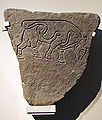Burghead Bulls
 From Wikipedia the free encyclopedia
From Wikipedia the free encyclopedia
The Burghead Bulls are a group of carved Pictish stones from the site of Burghead Fort in Moray, Scotland, each featuring an incised image of a bull. Up to 30 were discovered during the demolition of the fort to create the town of Burghead in the 19th century, but most were lost when they were used to build the harbour quayside.[1] Six remain: two in the Visitor Centre in Burghead, two in Elgin Museum, one in the National Museum of Scotland in Edinburgh, and one in the British Museum in London.
Interpretation of the stones' original role has varied. Some scholars have suggested they were displayed on the fort's ramparts as symbols of power; others have seen them as having a votive role in a frieze as part of a pagan fertility cult; while others argue they were standing stones lining a processional route through the ramparts, a role suggested by their likely original kite-shaped form.[2] The Bulls probably represent an early pre-Christian phase of the fort's existence in the 7th or late 6th centuries, while the later shrine panels and cross-slabs represented by the Burghead sculpture fragments indicate the presence of an Early Christian centre during a later period, as the association between the church and royal power grew from the 7th century onwards.[3]
- Burghead 1 on display at the National Museum of Scotland, Edinburgh
- Burghead 2 on display at Burghead Visitor Centre
- Burghead 3 on display at Elgin Museum
- Burghead 5 on display at the British Museum, London
- Burghead 6 on display at Elgin Museum
| Type | Date | Material and Dimensions | Location found | Date found | Current location | Notes | |
|---|---|---|---|---|---|---|---|
| Burghead 1 | Symbol stone | 7th century | Sandstone, H 0.69m x W 0.43m x D 0.08m | Burghead Fort or Burghead Well | 1809 | National Museum of Scotland, Edinburgh | Some sources claim that this was discovered in Burghead Well, but the earliest source is clear that it was in fact discovered during quarrying of the fort ramparts in 1809.[4] |
| Burghead 2 | Symbol stone fragment | 7th century | Sandstone, H 0.31m x W 0.48m x D 0.10m | South Quay, Burghead Harbour | 1862 | Burghead Visitor Centre | [5] |
| Burghead 3 | Symbol stone fragment | 7th century | Sandstone, H 0.41m x W 0.53m x D 0.18m | Burghead | Before 1867 | Elgin Museum | [6] |
| Burghead 4 | Symbol stone fragment | 7th century | Sandstone, H 0.28m x W 0.28m x D 0.10m | South Quay, Burghead Harbour | 1867 | Burghead Visitor Centre | Discovered during the demolition of a house in South Quay.[7] |
| Burghead 5 | Symbol stone | 7th century | Sandstone, 0.53m x W 0.53m x D 0.08m | Burghead | Before 1809 | British Museum, London | Exhibited at the Society of Antiquaries in London in 1809.[8] |
| Burghead 6 | Symbol stone fragment | 7th century | Sandstone, H 0.61m x W 0.46m x D 0.15m | South Quay, Burghead Harbour | 1884 | Elgin Museum | [9] |
References
[edit]- ^ Driscoll, Stephen T. (2007). "Burghead". In Lynch, Michael (ed.). The Oxford Companion to Scottish History. Oxford: Oxford University Press. p. 58. ISBN 9780199234820. Retrieved 1 May 2021.
- ^ Noble 2019, p. 54.
- ^ Noble 2019, pp. 54–55.
- ^ Ritchie, A (2017). "Burghead 1, Moray, Pictish symbol stone". Canmore. Historic Environment Scotland. Retrieved 1 May 2021.
- ^ Ritchie, A (2017). "Burghead 2, Moray, Pictish symbol stone fragment". Canmore. Historic Environment Scotland. Retrieved 1 May 2021.
- ^ Ritchie, A (2017). "Burghead 3, Moray, Pictish symbol stone fragment". Canmore. Historic Environment Scotland. Retrieved 1 May 2021.
- ^ Ritchie, A (2017). "Burghead 4, Moray, Pictish symbol stone fragment". Canmore. Historic Environment Scotland. Retrieved 1 May 2021.
- ^ Ritchie, A (2017). "Burghead 5, Moray, Pictish symbol stone". Canmore. Historic Environment Scotland. Retrieved 1 May 2021.
- ^ Ritchie, A (2017). "Burghead 6, Moray, Pictish symbol stone fragment". Canmore. Historic Environment Scotland. Retrieved 1 May 2021.
Bibliography
[edit]- Noble, Gordon (2019). "Fortified settlement in northern Pictland". In Noble, Gordon; Evans, Nicholas (eds.). The King in the North: The Pictish Realms of Fortriu and Ce. Birlinn. pp. 39–57. ISBN 178027551X.




